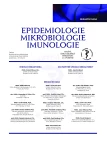MAIT cells, their biological and medical significance
Authors:
M. Buc
Authors‘ workplace:
Imunologický ústav Lekárskej fakulty Univerzity Komenského, Bratislava, Slovenská republika
Published in:
Epidemiol. Mikrobiol. Imunol. 69, 2020, č. 4, s. 189-193
Category:
Review articles, original papers, case report
Overview
MAIT cells are a separate cell population differentiating in the thymus. They are mostly present in the peripheral blood, liver, intestine, and lungs, less often in other tissues, and infrequently in the lymph nodes. The presentation molecules for MAIT cells are MR1 proteins. They are evolutionarily conserved and non-polymorphic, resemble class I HLA molecules, and are expressed by all cell types. They present bacterial and yeast vitamin metabolites which arise during the synthesis of vitamin B2. The effector functions of MAIT cells are promoted through cytokine synthesis. They also act cytotoxically, directly killing infected or tumour cells. MAIT cells may also play a role in pathological processes. Their involvement in the development of rheumatoid arthritis, systemic lupus erythematosus, autoimmune diabetes mellitus, Crohn's disease, and bronchial asthma has been demonstrated. In practical terms, MAIT cells are very sensitive to therapeutic doses of glucocorticoids. Treatment of patients with BA or chronic obstructive pulmonary disease with glucocorticoids increases their susceptibility to pneumonia, especially when caused by Streptococcus pneumoniae.
Keywords:
MAIT cells – presentation molecule MR1 – role in disease pathogenesis – susceptibility to glucocorticoids
Sources
1. Godfrey DI, Uldrich AP, McCluskey J, et al. The burgeoning family of unconventional T cells. Nat Immunol, 2015;16(11):1114–1123.
2. Koay HF, Gherardin NA, Anselm Enders A, et al. A three-stage intrathymic development pathway for the mucosal-associated invariant T cell lineage. Nat Immunol, 2016;17(11):1300–1311.
3. Franciszkiewicz K, Salou, Legoux F, et al, MHC class I-related molecule, MR1, and mucosal-associated invariant T cells. Immunol Rev, 2016;272(1):120–138.
4. Ghazarian LS, Caillat-Zucman S, Houdouin V. Mucosal-Associated invariant T cell interactions with commensal and pathogenic bacteria: Potential role in antimicrobial immunity in the child. Front Immunol, 2017;8:1837.
5. Ohnuma K, Dang NH, Morimoto C. Revisiting an old acquaintance: CD26 and its molecular mechanisms in T cell function. Trends Immunol, 2008;29(6):295–301.
6. Rudak PT, Choi J, Haeryfar SMM. MAIT cell-mediated cytotoxicity: Roles in host defense and therapeutic potentials in infectious diseases and cancer. J Leukoc Biol, 2018;104(3):473–486.
7. Gibbs A, Leeansyah E, Introini A, et al. MAIT cells reside in the female genital mucosa and are biased towards IL-17 and IL-22 production in response to bacterial stimulation. Mucosal Immunol, 2017;10(1):35–45.
8. Kjer-Nielsen L, Patel O, Corbett AJ, et al. MR1 presents microbial vitamin B metabolites to MAIT cells. Nature, 2012;491(7426):717–723.
9. Birkinshaw RW, Kjer-Nielsen L, Eckle SBG, et al. MAITs, MR1 and vitamin B metabolites. Curr Opin Immunol, 2014;26:7–13.
10. Kurioka A, Ussher JE, Cosgrove C, et al. MAIT cells are licensed through granzyme exchange to kill bacterially sensitized targets. Mucosal Immunol, 2015;8(2):429–440.
11. Garrett WS. Immune recognition of microbial metabolites. Nat Rev Immunol, 2020; 20(2):91–92.
12. Kursunel MA, Esendagli G. The untold story of IFN-gamma in cancer biology. Cytokine Growth Factor Rev., 2016;31:73–81.
13. Ling L, Lin Y, Zheng W, et al. Circulating and tumor-infiltrating mucosal associated invariant T (MAIT) cells in colorectal cancer patients. Sci Rep, 2016;6:20358.
14. Hayashi E, Chiba A, Tada K. et al. Involvement of mucosal-associated invariant T cells in ankylosing spondylitis. J Rheumatol, 2016;43(9):1695–1703.
15. Singh S, Wu T, Xie C, et al. Urine VCAM-1 as a marker of renal pathology activity index in lupus nephritis. Arthritis Res Ther, 2012;14(4):R164.
16. Tastan C, Karhan E, Zhou W, et al. Tuning of human MAIT cell activation by commensal bacteria species and MR1-dependent T-cell presentation. Mucosal Immunol, 2018;11(6):1591–1605.
17. Ishimori A, Harada N, Chibaet A, et al. Circulating activated innate lymphoid cells and mucosal-associated invariant T cells are associated with airflow limitation in patients with asthma. Allergol Int, 2017;66(2):302–309.
18. Talbot TR, Hartert TV, Mitchel E. Asthma as a risk factor for invasive pneumococcal disease. N Engl J Med, 2005;352(20):2082–2090.
Labels
Hygiene and epidemiology Medical virology Clinical microbiologyArticle was published in
Epidemiology, Microbiology, Immunology

2020 Issue 4
Most read in this issue
- Data from the first wave of Covid-19 from the Central Military Hospital, Prague, Czech Republic
- Severe community-acquired pneumonia in intensive care
- Individualized dosing of vancomycin in geriatric patients
- MAIT cells, their biological and medical significance
